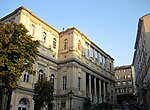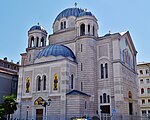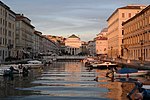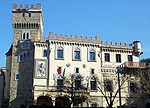Trieste ( tree-EST, Italian: [triˈɛste] (listen); Slovene: Trst [tə̀ɾst, tə́ɾst]; German: Triest [tʁiˈɛst] (listen)) is a city and seaport in northeastern Italy. It is the capital city, and largest city, of the autonomous region of Friuli Venezia Giulia, one of two autonomous regions which are not subdivided into provinces.
Trieste is located at the head of the Gulf of Trieste, on a narrow strip of Italian territory lying between the Adriatic Sea and Slovenia; Slovenia lies approximately 8 km (5 mi) east and 10–15 km (6–9 mi) southeast of the city, while Croatia is about 30 km (19 mi) to the south of the city.
The city has a long coastline and is surrounded by grassland, forest, and karstic areas. The city has a subtropical climate, unusual in relation to its relatively high latitude, due to marine breezes. In 2022, it had a population of about 204,302. Trieste is the capital of the autonomous region of Friuli Venezia Giulia and was previously capital of the Province of Trieste, until its abolition on 1 October 2017.Trieste belonged to the Habsburg monarchy from 1382 until 1918. In the 19th century the monarchy was one of the Great Powers of Europe and Trieste was its most important seaport. As a prosperous trading hub in the Mediterranean region, Trieste became the fourth largest city of the Austro-Hungarian Empire (after Vienna, Budapest, and Prague). In the fin de siècle period it emerged as an important hub for literature and music. Trieste underwent an economic revival during the 1930s, and the Free Territory of Trieste became a major site of the struggle between the Eastern and Western blocs after the Second World War.
Trieste, a deep-water port, is a maritime gateway for northern Italy, Germany, Austria and Central Europe. It is considered the end point of the maritime Silk Road, with its connections to the Suez Canal and Turkey. Since the 1960s, Trieste has emerged as a prominent research location in Europe because of its many international organisations and institutions. The city lies at the intersection of Latin, Slavic and Germanic cultures where Central Europe meets the Mediterranean Sea, and is home to diverse ethnic groups and religious communities.
Trieste has the highest percentage of researchers in Europe in relation to population. "Città della Barcolana", "Città della bora", "Città del vento", "Vienna by the sea" and "City of coffee" are also idioms used to describe Trieste.










